 ?Mathematical formulae have been encoded as MathML and are displayed in this HTML version using MathJax in order to improve their display. Uncheck the box to turn MathJax off. This feature requires Javascript. Click on a formula to zoom.
?Mathematical formulae have been encoded as MathML and are displayed in this HTML version using MathJax in order to improve their display. Uncheck the box to turn MathJax off. This feature requires Javascript. Click on a formula to zoom.ABSTRACT
Polysaccharide-based edible coating can be useful as a pretreatment for drying since it prevents the oxidation of nutritional compounds, thereby improving the quality of dried products. In this study, the effects of polysaccharide coating (xanthan and balangu seed gums) on the drying kinetics of apricot slices were investigated. In addition, genetic algorithm–artificial neural network (GA-ANN) and adaptive neuro-fuzzy inference system (ANFIS) models were used for prediction of drying time (DT) and moisture content (MC) of coated apricot slices in an infrared (IR) dryer. The GA-ANN and ANFIS were fed with two inputs of IR radiation intensity (150, 250, and 375 W) and the distance of slices from lamp surface (5, 7.5, and 10 cm) for prediction of average DT. Also, to predict the MC, these models were fed with three inputs of IR power, lamp distance, and treatment time. The developed GA-ANN, which included seven hidden neurons, predicted the DT of apricot slices with a correlation coefficient (r) of 0.970. Also, the GA-ANN model with nine neurons in one hidden layer predicts the MC with a high r-value (r = 0.999). The calculated r-values for prediction of DT and MC using the ANFIS-based subtractive clustering algorithm were 0.986 and 0.999, respectively, which showed a high correlation between predicted and experimental values. Sensitivity analysis results showed that IR intensity and treatment time were the most sensitive factors for prediction of DT and MC of coated apricot slices, respectively. Both GA-ANN and ANFIS models’ predictions agreed well with testing data sets, and they could be useful for understanding and controlling the factors affecting on drying kinetics of apricot slices in an IR dryer.
Abbreviations
| ANFIS | = | adaptive neuro-fuzzy inference system |
| ANN | = | artificial neural networks |
| IR | = | infrared |
| MC | = | moisture content |
| MF | = | membership functions |
| r | = | correlation coefficient |
| SC | = | subtractive clustering |
Introduction
Apricot fruit (Prunus armeniaca L.) is a drupe (a stone fruit) whose size ranges from 1.5 to 2.5 cm in diameter. Apricots can be considered as a good source of phytochemicals such as polyphenols, carotenoids (β‐carotene), and vitamins, which significantly contribute to their taste, color, and nutritional and functional values, that are beneficial for human health. Apricot is a climacteric fruit with a very short storage life due, in part, to a high respiration rate and a rapid ripening process. To extend the shelf life of apricot, different preservation methods have been developed including canning, freezing, and drying (Fratianni et al., Citation2013; Igual et al., Citation2012; Ihns et al., Citation2011; Satorabi et al., Citation2021). For example, the effect of processing on the drying kinetics and functional value of dried apricot (using hot air drying and microwave energy) was studied by Igual et al. (Citation2012). The authors reported that the microwave-dried samples maintained the same antioxidant capacity as the air-dried ones. Also, microwave application reduces drying time (DT) and increases apricot phenol content. In another study, Ihns et al. (Citation2011) examined the effect of temperature on the drying characteristics, color, antioxidant, and β‐carotene contents of two apricot varieties. These authors reported that the chroma, hue angle, and browning index values of both dried apricot varieties decreased with increasing temperature, and the hydrophilic oxygen reactive antioxidant capacity and β‐carotene contents increased with drying temperature.
Drying is one of the simply available and the most common processing approaches that has been used traditionally for product preservation. One of the ways to reduce the drying timeDT is to supply heat by infrared (IR) radiation. IR technique could be used as a substitution to the current drying techniques for manufacture of high-quality dried hydrocolloids. It has many advantages such as high heat transfer rate, uniform heating, low processing time, high performance (80–90%), lower energy utilization, lower energy costs, and improving final product quality (Aktaş et al., Citation2017; Salehi, Citation2020d). In addition, the use of an IR dryer in combination with other dryers helped to decrease the DT by raising the drying rate that leads to reduced energy utilization. Also, symmetrical temperature sharing by IR improved the final product quality (Baeghbali et al., Citation2019).
Edible coatings applied to food slices prior to drying is a technology that can improve the nutritional and sensory qualities of dehydrated products. The edible coatings have been widely studied aiming to increase the shelf life of minimally processed products and reduce the solid uptake during osmotic dehydration. Polysaccharide edible coatings present low water vapor barrier; however, they present good gas barrier properties, such as oxygen barrier, and could be used to minimize oxidative reactions in food during drying, pointing out the potential of using edible coatings prior to convective drying, since it could reduce undesirable changes due to large time of exposure of the food to oxygen (Fakhouri et al., Citation2007; Garcia et al., Citation2014; Salehi, Citation2020a; Silva et al., Citation2015). Garcia et al. (Citation2014) reported that coating with edible pectin reduced vitamin C losses during convective drying of papaya slices when compared to the uncoated samples, showing that the coating protected samples against oxidation of this biologically active compound. In addition, edible coatings differently affected the lightness of the samples during air dehydration, and pectin coating showed the slightest change at this color parameter.
Balangu (Lallemantia royleana L.) is the mucilaginous native plant, and its seeds have a high content of mucilage (gums) with outstanding useful characteristics that are comparable with marketable food gums. Major properties of the balangu seed gum as a novel source of gum have been recently reported by Salehi (Citation2020b). The use of seed gums such as balangu seed gum to manufacture edible films and coatings has also received attention due to its transparency, flexibility, biodegradable property, and oxygen barrier property (Salehi, Citation2019a).
The performance of artificial neural networks (ANNs) and adaptive neuro-fuzzy inference system (ANFIS) as an analytical alternative to conventional modeling techniques was reported by some researchers (Amini et al., Citation2021; Bahramparvar et al., Citation2014; Zhang et al., Citation2014). Salehi (Citation2020c) reported that these approaches are able to estimate drying kinetics of various fruits and vegetables with high precision. It has been shown that nonlinear approaches based on ANN are far better in generalization and estimation in comparison to empirical models. Determination of the best number of neurons in hidden layers of ANN models is generally carried out by trial and error (Bahramparvar et al., Citation2014; Salehi and Razavi, Citation2012). The genetic algorithm (GA) optimization method can be used to overcome this inherent limitation of ANN. GA is the search technique for optimal value, mimicking the mechanism of biological evolution. It has a high capability to find the optimum value of a complex objective function, without falling into local optima (Ramzi et al., Citation2015; Salehi, Citation2020c).
ANFIS is a well-known hybrid neuro-fuzzy network for modeling complex systems. ANFIS merge the human-like reasoning style of fuzzy inference systems (FIS) through the employ of fuzzy sets and a linguistic model including of a set of If-Then fuzzy rules. The main strength of ANFIS models is that they are universal approximators with the ability to solicit interpretable If-Then rules. One approach to the derivation of the fuzzy rule base is to use the self-learning features of ANN, to define the membership functions (MFs) based on input–output data (Amini et al., Citation2021; Ramzi et al., Citation2015; Salehi, Citation2020c). Fuzzy clustering technique is the strategy used to identify the MF by organizing data samples into clusters so that the data samples within clusters have the most similarity to each other. The most frequently used fuzzy clustering method is the fuzzy subtractive clustering (SC) algorithm. In this algorithm, a cluster with a certain degree has each data point, explained by an MF level. The quantity of neuron rules for the model obtained by SC technique is very lower than the model obtained by other techniques (grid partition) (Al-Amoudi et al., Citation2019; Chen, Citation2013; Keshavarzi et al., Citation2017; Madadlou et al., Citation2010). ANFIS model was used to predict the drying kinetics of different fruits and vegetables (Salehi, Citation2020c).
It is difficult to predict the combined effect of IR power, lamp distance, and treatment time on drying kinetics [DT and moisture content (MC)] of fruits and vegetables using conventional models. Therefore, the target of this study was to investigate the effect of IR dryer parameters on DT and MC of coated apricot slices with xanthan and balangu seed gums during IR drying and studying the performance of GA-ANN and ANFIS methods to estimate these parameters.
Materials and Methods
Sample Preparation
Slices of apricot (5 mm thick), 35 mm in diameter, were prepared with the aid of a cutter and a steel-made cutting tool, which was cylindrical in shape and pointed on one of the sides. The initial MC of the apricot slice was 89% (wet basis).
Balangu Seed Gum Extraction
Balangu (L. royleana L.) seeds were physically cleaned and all foreign stuffs removed. Then, the pure balangu seeds were immersed in water for 20 min at a seed/water relation of 1:20 at 25°C. In the next step, the gum was separated from the inflated seeds by passing the seeds through an extractor (Bellanzo BFP-1540 Juicer, China) with a rotating disc that scratches the mucilage layer on the seed surface. The initial MC of the balangu seed gum was 99.4% (wet basis).
Xanthan Gum
Xanthan gum (food grade) was purchased from FuFeng Co., Ltd (China).
Coating of Apricot Slices
Xanthan and balangu seed gums were used to coat the fresh apricot slices. A 0.6% (w/w) xanthan and balangu seed gums solution was prepared at 25°C, and then apricot slices were immersed for 1 min in an aqueous solution.
IR Drying
In this study, a dryer (length 44 cm, width 20 cm, and height 40 cm) with an IR radiation source was used for dehydration (). The coated apricot slices were dried in an IR dryer [IR radiation lamp (NIR), Noor Lamp Company, Iran]. The influence of IR radiation power (at three levels 150, 250, and 375 W), distance of sample from lamp (at three levels 5, 7.5, and 10 cm), and time (min) on drying kinetics of apricot slices was examined. The weight changes of apricot slices were measured by using Lutron GM-300p digital balance (Taiwan, the sensitivity of ±0.01 g). All measurements were done in triplicate.
Modeling
IR radiation power and the distance of apricot slices from lamp surface (two inputs) were used as inputs and average DT values were used as an output. Also, to predict the MC, IR power, lamp distance, and treatment time (three inputs) were used as inputs and MC values were used as output for the GA-ANN () and ANFIS models (). In the present study for each treatment (uncoated, coated by xanthan gum, or coated by balangu seed gum), 27 data series [(3 (power) × 3 (distance) × 3 (repeat)] for average DT and 2241 data [3 (power) × 3 (distance) × 83 (average time) × 3 (repeat)] for MC were collected from experiments. The experimental data order was first randomized, and then total data were randomly separated into three partitions: training (30%), validating (20%), and testing data (50%). The testing data were used for prediction of the trained network performance on unseen data.
Figure 2. The genetic algorithm–artificial neural network model structures for prediction of the drying time (a) and moisture content (b) of apricot slices
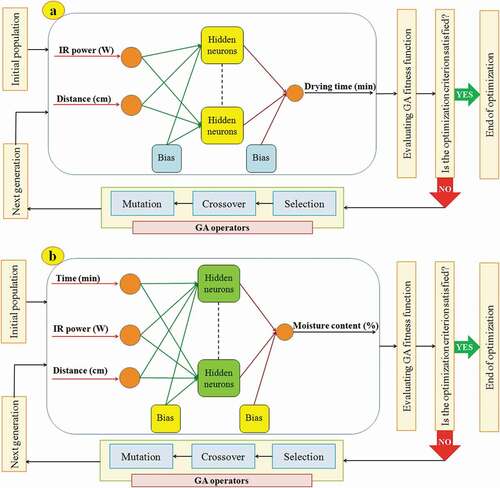
Figure 3. The adaptive neuro-fuzzy inference system model structures for prediction of the drying time and moisture content of apricot slices
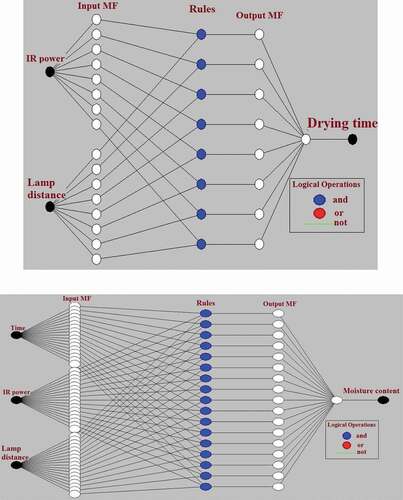
GA-ANN Modeling
In this study, the Neurosolution software (release 5, NeuroDimension, Inc., USA) was used for GA-ANN modeling. In the hidden layers and output layer, a sigmoid activation function was used (due to the highest r-values in comparison to the other functions, hyperbolic tangent and a linear) (EquationEq. 1)(1)
(1) .
The Levenberg–Marquardt optimization method was applied to network training. The crossover probability and mutation probability operators were adjusted equal to 0.9 and 0.01, respectively. Also, a sensitivity analysis was done to supply the measure of relative significance between the inputs of the ANN model and to show how the model output changed in response to input changes.
ANFIS Modeling
Matlab fuzzy logic toolbox (MATLAB R2012a, The MathWorks Inc., USA) was used in this study to build an ANFIS model for modeling and prediction of DT and MC of coated apricot slices during IR drying. There are two methods to construct the model in this toolbox: grid partition and SC. In the SC method, the MFs are obtained automatically after the generation of clusters (Jalal et al., Citation2020; Madadlou et al., Citation2010). With the number of inputs growing in the grid partition model, the MF shows exponential growth, thereby leading to a paralyzed calculation system. So, in this study, the SC algorithm was used to establish the type and quantity of MF. A hybrid training method (the mixture of least-squares and backpropagation algorithms) was used as a training method of the ANFIS. The ANFIS structure was trained with the range of influence = 0.5, squash factor = 1.25, accept ratio = 0.5, and reject ratio = 0.15.
Statistical Analysis
Statistical analysis of data was done in a factorial design by analysis of variance using SAS 9.1 statistical software (SAS Institute Inc., Cary, NC, USA). A significant difference between data means was determined using Duncan’s multiple-range test at α = 0.05 level, and it was performed to establish the impact of IR radiation power (at three levels 150, 250, and 375 W) and the distance of slices from lamp surface (5, 7.5, and 10 cm) on drying kinetics of apricot slices. All measurements were done in triplicate.
Results and Discussion
Moisture Content
The effects of coating type (uncoated, balangu gum, andxanthan gum), IR power, and sample distance on MC of apricot slices during IR drying are shown in . The general characteristic of the curves seen in this figure is their similarity as being a typical drying curve. As seen in this figure, MC declined exponentially with treatment time. DT declined with the increasing power because of the increasing temperature and heat transfer gradient between the air and sample. With IR intensity increasing, due to the increase in apricot slices and increasing evaporation rate and decrease in DT, the specific energy for drying of apricot slices decreases. The experimental results are consistent with the reported data for other products (Toğrul, Citation2006).
Figure 4. Variations of moisture content of coated apricot slices at different (a) coating type (250 W and 7.5 cm distance); (b) infrared power (7.5 cm distance, balangu coating); and (c) sample distance (150 W, balangu coating)
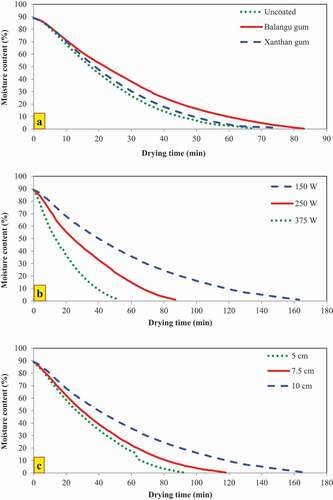
Modeling of mass transfer during IR drying of quince slice was investigated by Mehrnia et al. (Citation2017). The authors reported that the DT decreased when the sample distance from the IR lamp was reduced. Comparison of convective and IR heating as a means of drying pomegranate arils was studied by Briki et al. (Citation2019). The authors reported that the minimum times required to reach 9% moisture (w/w) starting from 78% were 510 and 94 min for convective and IR drying, respectively. In addition, Łechtańska et al. (Citation2015) examined the IR-assisted hot air drying of green pepper. They reported about 38% decrease in DT in comparison to drying by using hot air drying method. In another study, the effect of IR pretreatment on low humidity air drying of apple slices was investigated by Shewale and Hebbar (Citation2017). They observed that pretreatment with IR waves decreased the DT approximately to 23% and 17% in low-humidity air and hot air drying, respectively.
GA-ANN Modeling Results
GA-ANN models were developed for estimation of DT and MC of apricot slices during IR drying. In this research, the ANN model was trained using a GA to find the best network structure. It was found that GA-ANN with seven neurons in one hidden layer could estimate DT with a high r-value (r = 0.970). In addition, the GA-ANN model with nine neurons in one hidden layer could predict the MC with an r-value equal to 0.999.
The GA-ANN method alleviates the problem of determining the hidden neuron numbers and structure of the conventional ANN model layers by trial and error. Error values [mean squared error (MSE), normalized mean squared error (NMSE), and mean absolute error (MAE)] calculated by optimized GA-ANN model for prediction of DT and MC of apricot slices in an IR dryer are reported in . The calculated r-values for estimation of DT and MC of apricot slices during IR drying show a high correlation between estimated and experimental values. The results showed that satisfactory agreement between the predicted and experimental data could be achieved by using the GA-ANN model. In addition, the estimation performance of the GA-ANN model for unseen data for DT and MC is presented in .
Table 1. Error values calculated by optimized GA-ANN approach for estimation of drying time and moisture content of apricot slices in an infrared dryer
Figure 5. Experimental versus predicted values of drying time (a) and moisture content (b) of coated apricot slices by balangu seed gum (using genetic algorithm–artificial neural network model)
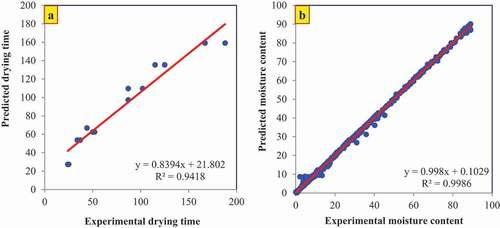
demonstrate the best GA-ANN network weight and bias values for DT and MC changes of apricot slices drying, respectively, which could be used in a computer program for prediction of these parameters.
Table 2. The weight and bias data of the best GA-ANN structure for estimation of drying time
Table 3. The weight and bias data of the best GA-ANN structure for estimation of moisture content
Sensitivity analysis was used to examine the sensitiveness of GA-ANN structures toward various inputs (). Sensitivity analysis results demonstrated that IR intensity and treatment time were the major sensitive inputs for estimation of DT and MC of apricot slices in an IR dryer, respectively.
ANFIS Modeling Results
The designed ANFIS structure is presented in for the DT of apricot slices in an IR dryer comprising two nodes in an input layer (IR power and apricot slices distance), eight nodes in the hidden layer, and one node (DT) in the output layer. The ANFIS network was trained with 200 observations that were used to build the model. Finally, the ANFIS structure for estimating the DT of apricot slices, with eight Gaussian-type MF for two inputs and linear MF for output, and creation of eight rules resulted in good accurate estimation ()).
Figure 7. Response surface diagram for infrared radiation intensity and distance of apricot slices from lamp surface (coated by balangu seed gum) versus drying time (a). Fuzzy process for prediction of drying time (b)
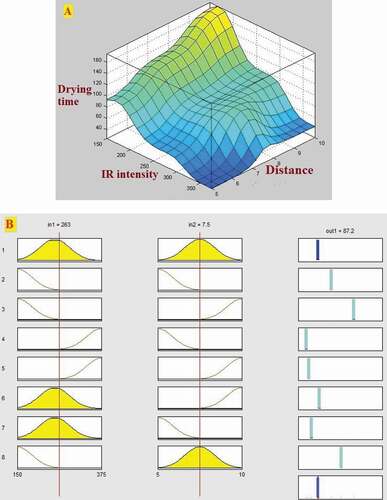
DT of apricot slices in IR dryer depends on many factors, including IR power and lamp distance from slices. A three-dimensional plot of DT values versus these parameters is illustrated in . This figure demonstrates the total system response surface for IR power and slices distance versus DT. It was observed that there is a nonlinear relationship among the input parameters and DT and the relationship of parameters was complex. As shown in ), the best Sugeno fuzzy model was got when the rules are equal to 8. The reasoning procedure demonstrates that the DT of apricot slices would be equal to 87.2 min if the input parameters, IR power and slices distance, equal to 263 W and 7.5 cm, respectively.
The designed ANFIS structure is presented in for the MC changes of apricot slices in an IR dryer comprising 3 nodes in the input layer (IR power, apricot distance, and treatment time), 17 nodes in the hidden layer, and 1 node (MC) in the output layer. Also, the optimal combination of the ANFIS model was acquired when the number of rules is equal to 17.
In , the DT and MC values versus ANFIS estimation for unseen data (test data) points are shown. It can be seen that the system was well-trained to model these parameters. The calculated r-values for estimation of DT and MC were 0.986 and 0.999, respectively, which shows a high correlation between predicted and experimental values. Generally, these models simply explain the very nonlinear process including IR drying without the need to establish the complicated mechanisms involved in it.
Figure 8. Experimental versus predicted values of drying time (a) and moisture content (b) of coated apricot slices by balangu seed gum (using adaptive neuro-fuzzy inference system model)
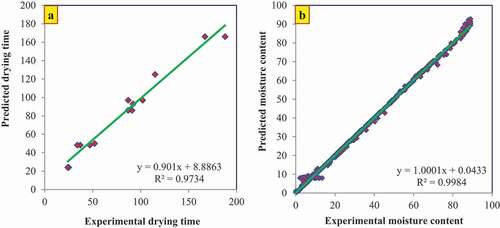
Rahman et al. (Citation2012) modeled the effect of thermal conductivity of different fruits and vegetables by multivariable regression, ANN, and neuro-fuzzy models. Between these, the ANFIS approach estimated the conductivity values closer to the experimental data by providing the lowest errors. Lertworasirikul (Citation2008) performed a comparative study on the drying kinetics of semi-finished cassava crackers using empirical, ANN, and ANFIS models, and predicted the dynamic drying parameters. In another study, Ojediran et al. (Citation2020) used ANFIS to predict the drying kinetics during the drying of yam slices in a convective hot air dhoryer. In this study, the experiments were done at various drying air temperatures (50, 60, and 70°C), air velocities (0.5, 1.0, and 1.5 m/s), and yam slices thickness (3, 6, and 9 mm), and the obtained experimental data were used to model and check the advantage of ANFIS approach. The result displayed the efficiency of ANFIS in predicting of drying kinetics at every time and condition of drying with the correlation value of 0.98 for the testing data.
Conclusions
In this study, the influence of IR drying parameters, including radiation power, the distance of slices from IR lamp, treatment time on DT, and MC of coated apricot slices by xanthan and balangu seed gums, was studied. Also, the use of GA-ANN and ANFIS methods for estimation of these parameters was investigated. It was found that the GA-ANN with one hidden layer using seven neurons gives the best fitting with the experimental drying data, making it possible to predict DT with an acceptable r-value (0.970). Also, to predict the MC, these models were fed with three inputs of IR power, lamp distance, and treatment time, and the GA-ANN model with nine neurons in one hidden layer predicts the MC with a high r-value (r = 0.999). The ANFIS model, based on the Sugeno-type FIS with 8 and 17 Gaussian-type MF, gives the total best fit for DT and MC, respectively, yielding r-values as high as 0.986 and 0.999, respectively. The results indicated that both GA-ANN and ANFfIS approaches could give a good estimation of DT and MC of coated apricot slices by xanthan and balangu seed gums during IR drying.
References
- Aktaş, M., A. Sözen, A. Amini, and A. Khanlari. 2017. Experimental analysis and CFD simulation of infrared apricot dryer with heat recovery. Drying Technol. 35(6):766–783. doi: https://doi.org/10.1080/07373937.2016.1212871.
- Al-Amoudi, R.H., O. Taylan, G. Kutlu, A.M. Can, O. Sagdic, E. Dertli, and M.T. Yilmaz. 2019. Characterization of chemical, molecular, thermal and rheological properties of medlar pectin extracted at optimum conditions as determined by Box-Behnken and ANFIS models. Food Chem. 271:650–662. doi: https://doi.org/10.1016/j.foodchem.2018.07.211.
- Amini, G., F. Salehi, and M. Rasouli. 2021. Drying kinetics of basil seed mucilage in an infrared dryer: Application of GA-ANN and ANFIS for the prediction of drying time and moisture ratio. J. Food Process. Preserv. 1–9. doi: https://doi.org/10.1111/jfpp.15258.
- Baeghbali, V., M. Niakousari, M.O. Ngadi, and M. Hadi Eskandari. 2019. Combined ultrasound and infrared assisted conductive hydro-drying of apple slices. Drying Technol. 37(14):1793–1805. doi: https://doi.org/10.1080/07373937.2018.1539745.
- Bahramparvar, M., F. Salehi, and S. Razavi. 2014. Predicting total acceptance of ice cream using artificial neural network. J. Food Process. Preserv. 38(3):1080–1088. doi: https://doi.org/10.1111/jfpp.12066.
- Briki, S., B. Zitouni, B. Bechaa, and M. Amiali. 2019. Comparison of convective and infrared heating as means of drying pomegranate arils (Punica granatum L.). Heat Mass Transfer. 55(11):3189–3199. doi: https://doi.org/10.1007/s00231-019-02644-8.
- Chen, M.-Y. 2013. A hybrid ANFIS model for business failure prediction utilizing particle swarm optimization and subtractive clustering. Inf Sci (Ny). 220:180–195. doi: https://doi.org/10.1016/j.ins.2011.09.013.
- Fakhouri, F.M., L.C.B. Fontes, P.V.D.M. Gonçalves, C.R. Milanez, C.J. Steel, and F.P. Collares-Queiroz. 2007. Filmes e coberturas comestíveis compostas à base de amidos nativos e gelatina na conservação e aceitação sensorial de uvas Crimson. Food Sci. Technol. 27(2):369–375. doi: https://doi.org/10.1590/S0101-20612007000200027.
- Fratianni, A., D. Albanese, R. Mignogna, L. Cinquanta, G. Panfili, and M. Di Matteo. 2013. Degradation of carotenoids in apricot (Prunus armeniaca L.) during drying process. Plant Foods Hum. Nutr. 68(3):241–246. doi: https://doi.org/10.1007/s11130-013-0369-6.
- Garcia, C.C., L.C. Caetano, K. De Souza Silva, and M.A. Mauro. 2014. Influence of edible coating on the drying and quality of papaya (Carica papaya). Food Bioprocess Tech. 7(10):2828–2839. doi: https://doi.org/10.1007/s11947-014-1350-6.
- Igual, M., E. García-Martínez, M.E. Martín-Esparza, and N. Martínez-Navarrete. 2012. Effect of processing on the drying kinetics and functional value of dried apricot. Food Res. Int. 47(2):284–290. doi: https://doi.org/10.1016/j.foodres.2011.07.019.
- Ihns, R., L.M. Diamante, G.P. Savage, and L. Vanhanen. 2011. Effect of temperature on the drying characteristics, colour, antioxidant and beta-carotene contents of two apricot varieties. Int. J. Food Sci. Tech. 46(2):275–283. doi: https://doi.org/10.1111/j.1365-2621.2010.02506.x.
- Jalal, M., Z. Grasley, N. Nassir, and H. Jalal. 2020. Strength and dynamic elasticity modulus of rubberized concrete designed with ANFIS modeling and ultrasonic technique. Constr. Build. Mater. 240(117920):117920. doi: https://doi.org/10.1016/j.conbuildmat.2019.117920.
- Keshavarzi, A., F. Sarmadian, J. Shiri, M. Iqbal, R. Tirado-Corbalá, and E.-S.E. Omran. 2017. Application of ANFIS-based subtractive clustering algorithm in soil cation exchange capacity estimation using soil and remotely sensed data. Measurement. 95:173–180. doi: https://doi.org/10.1016/j.measurement.2016.10.010.
- Łechtańska, J.M., J. Szadzińska, and S.J. Kowalski. 2015. Microwave- and infrared-assisted convective drying of green pepper: Quality and energy considerations. Chem. Eng. Process. 98:155–164. doi: https://doi.org/10.1016/j.cep.2015.10.001.
- Lertworasirikul, S. 2008. Drying kinetics of semi-finished cassava crackers: A comparative study. LWT- Food Sci. Technol. 41(8):1360–1371. doi: https://doi.org/10.1016/j.lwt.2007.09.009.
- Madadlou, A., Z. Emam-Djomeh, M.E. Mousavi, and M. Javanmard. 2010. A network-based fuzzy inference system for sonodisruption process of re-assembled casein micelles. J Food Eng 98(2):224–229. doi: https://doi.org/10.1016/j.jfoodeng.2009.12.031.
- Mehrnia, M.A., A. Bashti, and F. Salehi. 2017. Experimental and modeling investigation of mass transfer during infrared drying of Quince. Iranian Food Sci. Technol. Res. J. 12(6):758–766.
- Ojediran, J.O., C.E. Okonkwo, A.J. Adeyi, O. Adeyi, A.F. Olaniran, N.E. George, and A.T. Olayanju. 2020. Drying characteristics of yam slices (Dioscorea rotundata) in a convective hot air dryer: Application of ANFIS in the prediction of drying kinetics. Heliyon. 6(3):e03555. doi: https://doi.org/10.1016/j.heliyon.2020.e03555.
- Rahman, M.S., M.M. Rashid, and M.A. Hussain. 2012. Thermal conductivity prediction of foods by neural network and fuzzy (ANFIS) modeling techniques. Food Bioprod. Process. 90(2):333–340. doi: https://doi.org/10.1016/j.fbp.2011.07.001.
- Ramzi, M., M. Kashaninejad, F. Salehi, A.R. Sadeghi Mahoonak, and S.M. Ali Razavi. 2015. Modeling of rheological behavior of honey using genetic algorithm–artificial neural network and adaptive neuro-fuzzy inference system. Food Biosci. 9:60–67. doi: https://doi.org/10.1016/j.fbio.2014.12.001.
- Salehi, F. 2019a. Characterization of new biodegradable edible films and coatings based on seeds gum: A review. J. Package. Technol. Res. 3(2):193–201. doi: https://doi.org/10.1007/s41783-019-00061-0.
- Salehi, F. 2020a. Effect of coatings made by new hydrocolloids on the oil uptake during deep‐fat frying: A review. J. Food Process. Preserv. 44(11):1–12. doi: https://doi.org/10.1111/jfpp.14879.
- Salehi, F. 2020b. Effect of common and new gums on the quality, physical, and textural properties of bakery products: A review. J. Texture Stud. 51(2):361–370. doi: https://doi.org/10.1111/jtxs.12482.
- Salehi, F. 2020c. Recent advances in the modeling and predicting quality parameters of fruits and vegetables during postharvest storage: A review. Int. J. Fruit Sci. 20(3):506–520. doi: https://doi.org/10.1080/15538362.2019.1653810.
- Salehi, F. 2020d. Recent applications and potential of infrared dryer systems for drying various agricultural products: A review. Int. J. Fruit Sci. 20(3):586–602. doi: https://doi.org/10.1080/15538362.2019.1616243.
- Salehi, F., and S.M.A. Razavi. 2012. Dynamic modeling of flux and total hydraulic resistance in nanofiltration treatment of regeneration waste brine using artificial neural networks. Desalinat. Water Treat. 41(1–3):95–104. doi: https://doi.org/10.1080/19443994.2012.664683.
- Satorabi, M., F. Salehi, and M. Rasouli. 2021. Investigation of the effects of coating with xanthan and Balangu seed gums on the drying time of apricot slices in infrared system. Iran. J. Food Sci. Technol. 18(111):295–303.
- Shewale, S.R., and H.U. Hebbar. 2017. Effect of infrared pretreatment on low-humidity air drying of apple slices. Drying Technol. 35(4):490–499. doi: https://doi.org/10.1080/07373937.2016.1190935.
- Silva, K.S., C.C. Garcia, L.R. Amado, and M.A. Mauro. 2015. Effects of edible coatings on convective drying and characteristics of the dried pineapple. Food Bioprocess Tech. 8(7):1465–1475. doi: https://doi.org/10.1007/s11947-015-1495-y.
- Toğrul, H. 2006. Suitable drying model for infrared drying of carrot. J. Food Eng. 77(3):610–619. doi: https://doi.org/10.1016/j.jfoodeng.2005.07.020.
- Zhang, Y., S. Wang, G. Ji, and P. Phillips. 2014. Fruit classification using computer vision and feedforward neural network. J Food Eng. 143:167–177. doi: https://doi.org/10.1016/j.jfoodeng.2014.07.001.


